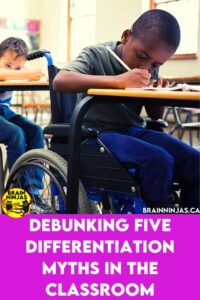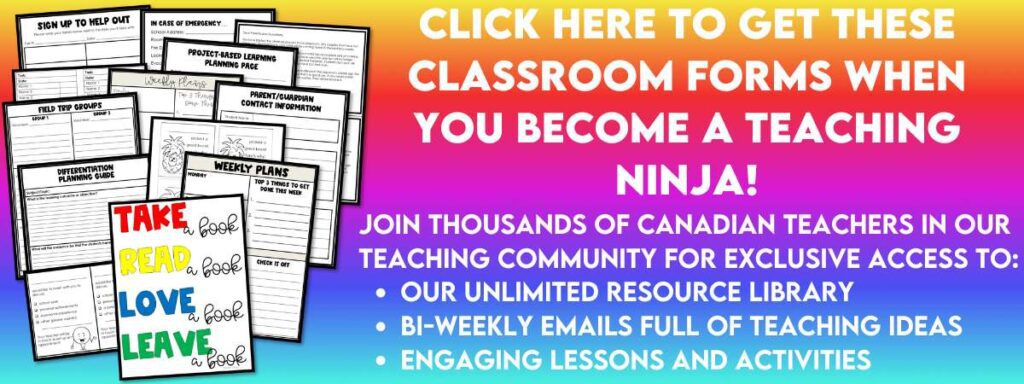
We thought we had heard all the possible excuses for not differentiating instruction until this week during a professional development session. We were shocked to overhear (and in some cases, be told straight out to our faces) some of the reasons teachers are not differentiating for their students. Here are five differentiation myths we heard and the reasons the people who said them are misinformed.
Today’s Classrooms Are Different, but the Differentiation Myths Are the Same!
Classrooms have changed. You got a collection of diverse learners in your room, so it’s easy to feel overwhelmed with trying to figure out the various complexities. It leaves you feeling like you’re not good at any of it.
Chances are, you’re better than you think you are. You just feel like it’s not working because you care about your students so much.
We recently presented at a teachers’ conference about the different ways to differentiate in your classroom and we were so surprised by the pushback we received from some of the teachers. Instead of approaching differentiation as a skill all teachers need to learn, some took it to mean they needed to change everything they were doing.
That’s not quite where we were going with our ideas. Here are the differentiation myths that popped up and how we responded to them.
Differentiation Myth #1: It’s too much work.

Actually, differentiating for all your students is a frame of mind. It’s a way of thinking, planning and preparing your room for the students you are teaching. This doesn’t mean you are creating different activities and lessons for every single student in your room.
Every student in your classroom can have the same project or end goal. The differentiation comes in the form of the support you’ll provide to your students. Once you have a set of supports in place for your students, the burden of the workload gets placed on them instead of you.
Your students should be doing the work. If you are differentiating, but it’s just creating different work for each person, you’re going to burn yourself out. If you only change your mind about one of the differentiation myths, choose this one.
You can read more about teaching students how to make choices for their own learning in our post Why You Should Allow Students Choices Every Day.
Differentiation Myth #2: I don’t have the technology, so I can’t differentiate for students.
While assistive technology (tools that use technology to make students more independent) is one of the many aspects that can make it easier to differentiate for your students, it is not the primary aspect of maintaining a classroom designed for differentiated instruction. It is just one ingredient.
As said before, differentiation is a mindset-not a list of things to do. Technology is a tool, so if it’s not available, then you will have to provide other supports that don’t use it.
BUT if you’re not using the available technology, you are probably making more work for yourself than is necessary. Yes, technology can be a challenge to use and maintain, but it can also free up a lot of your instructional time. Besides, your students are very comfortable with technology. They’ll teach you. All you have to do is provide the opportunities to use it.
This is one of those differentiation myths that need the support of the administration to make it work properly. You might need to show them this article if they need convincing.
The post Must Know Tech Skills might be helpful.
Differentiation Myth #3: If I make the work easy, won’t that keep them from learning it?

Uh, what? There are two problems with this statement.
First of all, differentiation does not mean you make the work easier. All work should be at the highest possible level that students can do for their age and grade independently.
Differentiation is not “dumbing it down.” Students need to feel challenged. Your job is to provide just enough support so that students can be challenged but complete the work as independently as possible.
Would you throw all your students in the deep end of the pool right away? Maybe you would give them some swimming lessons or hand them a life preserver so they can be in the deep end with support. Differentiation is not about making it easier. It’s about making it accessible to as many students as possible.
If you lower your expectations of what your students can achieve, they will rise to that-and only that. Keep your expectations high (as high as the grade level requires) for all your students, but support them in their journey to the top.
The second problem with this statement: you still have to teach it until they get it. That’s the goal. Scaffolding the work so your students can master skills over a period of time will strengthen their understanding and teach them the skill better in the long run — because you’ll be teaching it at the level they need but expecting your students to reach the top.
Differentiation will not prevent your students from learning. It’s the complete opposite.
Differentiation Myth #4: I already have too many different things I have to do. I don’t have time to teach a bunch of different lessons for different learning needs.

Differentiation is not about teaching everything all ways. It’s about teaching the way your students need it. Not every lesson needs to have several different ways for it to be done. Add in the differentiation supports when you know that your lesson won’t reach everyone. Try creating your lessons with the whole group in mind.
One way we learn about the learning needs of our students is through Learner Profiles & Surveys which you can find in our TPT Store ($USD) or BN Shop ($CAN).
Reading, writing, and math are the areas where you probably spend the majority of your time differentiating, but these are also the areas where it’s the simplest.
You probably already have Guided Reading groups. Or you probably already workshop with the writers in your class. You probably provide different worksheets for practice in math if students get stuck.
Balancing your whole group instruction with small group instruction is one way to differentiate naturally. It’s probably something you’re already doing in your classroom. If you need help in this area, try reading Help! I Have to Teach Guided Reading!
When it comes to social studies and science, provide the same differentiation supports to all your students. For example, read the article in social studies class to the whole class before they start to work on the task. Do a demonstration of the experiment in science class, so everyone sees how it works.
Art and physical education don’t need a lot of differentiation other than providing physical supports if your students need them-like paintbrushes with handles, taping a paper down before drawing, or a clipboard in art class. Depending on the physical needs of the student, allow the child to join in as much as possible.
Need help planning for differentiation?
The idea is to create one lesson for the whole class with one learning objective. But, then allow students to use the supports in place to work as independently as possible. This will free you up to support the learners who need extra support, but group these students together as much as possible when they need support with similar skills.
If you are looking for a way to help go through the process of differentiating your classroom and lessons without creating a thousand different lessons each time, download our Differentiation Planning Guide. It can also be found in our Resource Library, along with many other general classroom forms to help you organize your classroom. Or we can send a copy directly to your inbox when you sign up for our email list.
It comes with examples, instructions and a digital template you can use over and over to plan.
Differentiation Myth #5: If I give them all these special tools, won’t that make it harder for them when they grow up and can’t use them?

Do you use voice-to-text to save time when writing reminders or emails? Have you run a file through spell check before handing it to your boss? Do you use a calculator when you do your taxes?
The goal isn’t about doing things without using tools. The goal is to teach students to advocate for themselves to get the right tools for the job. They need to learn how and when to use appropriate tools and their function independently. You need to model how and when to use these tools for all your students so they can make good choices and work towards independence.
Remember when we were told we needed to learn math because we would never have a calculator at the grocery store? Nobody has taken away my calculator yet, so I guess that myth is debunked. Thank goodness for smartphones.
Adults naturally use the tools that make their lives easier, and they don’t need anyone’s permission to do it. It’s one of those differentiation myths that doesn’t actually play out in real life. Remember when all the teachers said we needed to learn math because we wouldn’t be able to take a calculator to the grocery store? Well, hello, smartphone!
This is just a glimpse into the world of differentiated instruction. Join us as we help debunk the differentiation myths, sort out the clutter and get you on your way to reaching all your students and teaching the best possible way you can.
You might be interested in reading some of our other posts about differentiation. It is truly a passion for us. How to Differentiate Your Instruction without it taking all your time is an overview of how you can streamline the process. Another great post is Differentiate in Less Time.
How is differentiation working for you (or not working for you)? Leave us a comment below, and maybe we can help you out or share your ideas with other teachers who are struggling.








Very informative
After reading the 5 myths of differentiation, it makes me feel good to know that I’ve been using some of these methods in class to help my students learn in different ways.
After reading this section it does make is easier to do differentiate remembering that the project and out come goal stays the same.
It just makes us (teachers) feel overwhelm thinking about all the students’ needs especially with everything else we have to do.
Good material and resources are a must.
It is hard to service each student all with different needs but we do our best.
Good insight!
good material